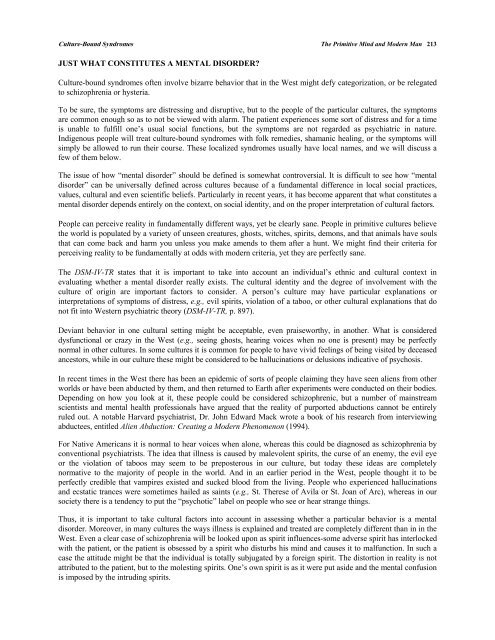chapter 1 - Bentham Science
chapter 1 - Bentham Science
chapter 1 - Bentham Science
You also want an ePaper? Increase the reach of your titles
YUMPU automatically turns print PDFs into web optimized ePapers that Google loves.
Culture-Bound Syndromes The Primitive Mind and Modern Man 213<br />
JUST WHAT CONSTITUTES A MENTAL DISORDER?<br />
Culture-bound syndromes often involve bizarre behavior that in the West might defy categorization, or be relegated<br />
to schizophrenia or hysteria.<br />
To be sure, the symptoms are distressing and disruptive, but to the people of the particular cultures, the symptoms<br />
are common enough so as to not be viewed with alarm. The patient experiences some sort of distress and for a time<br />
is unable to fulfill one’s usual social functions, but the symptoms are not regarded as psychiatric in nature.<br />
Indigenous people will treat culture-bound syndromes with folk remedies, shamanic healing, or the symptoms will<br />
simply be allowed to run their course. These localized syndromes usually have local names, and we will discuss a<br />
few of them below.<br />
The issue of how “mental disorder” should be defined is somewhat controversial. It is difficult to see how “mental<br />
disorder” can be universally defined across cultures because of a fundamental difference in local social practices,<br />
values, cultural and even scientific beliefs. Particularly in recent years, it has become apparent that what constitutes a<br />
mental disorder depends entirely on the context, on social identity, and on the proper interpretation of cultural factors.<br />
People can perceive reality in fundamentally different ways, yet be clearly sane. People in primitive cultures believe<br />
the world is populated by a variety of unseen creatures, ghosts, witches, spirits, demons, and that animals have souls<br />
that can come back and harm you unless you make amends to them after a hunt. We might find their criteria for<br />
perceiving reality to be fundamentally at odds with modern criteria, yet they are perfectly sane.<br />
The DSM-IV-TR states that it is important to take into account an individual’s ethnic and cultural context in<br />
evaluating whether a mental disorder really exists. The cultural identity and the degree of involvement with the<br />
culture of origin are important factors to consider. A person’s culture may have particular explanations or<br />
interpretations of symptoms of distress, e.g., evil spirits, violation of a taboo, or other cultural explanations that do<br />
not fit into Western psychiatric theory (DSM-IV-TR, p. 897).<br />
Deviant behavior in one cultural setting might be acceptable, even praiseworthy, in another. What is considered<br />
dysfunctional or crazy in the West (e.g., seeing ghosts, hearing voices when no one is present) may be perfectly<br />
normal in other cultures. In some cultures it is common for people to have vivid feelings of being visited by deceased<br />
ancestors, while in our culture these might be considered to be hallucinations or delusions indicative of psychosis.<br />
In recent times in the West there has been an epidemic of sorts of people claiming they have seen aliens from other<br />
worlds or have been abducted by them, and then returned to Earth after experiments were conducted on their bodies.<br />
Depending on how you look at it, these people could be considered schizophrenic, but a number of mainstream<br />
scientists and mental health professionals have argued that the reality of purported abductions cannot be entirely<br />
ruled out. A notable Harvard psychiatrist, Dr. John Edward Mack wrote a book of his research from interviewing<br />
abductees, entitled Alien Abduction: Creating a Modern Phenomenon (1994).<br />
For Native Americans it is normal to hear voices when alone, whereas this could be diagnosed as schizophrenia by<br />
conventional psychiatrists. The idea that illness is caused by malevolent spirits, the curse of an enemy, the evil eye<br />
or the violation of taboos may seem to be preposterous in our culture, but today these ideas are completely<br />
normative to the majority of people in the world. And in an earlier period in the West, people thought it to be<br />
perfectly credible that vampires existed and sucked blood from the living. People who experienced hallucinations<br />
and ecstatic trances were sometimes hailed as saints (e.g., St. Therese of Avila or St. Joan of Arc), whereas in our<br />
society there is a tendency to put the “psychotic” label on people who see or hear strange things.<br />
Thus, it is important to take cultural factors into account in assessing whether a particular behavior is a mental<br />
disorder. Moreover, in many cultures the ways illness is explained and treated are completely different than in in the<br />
West. Even a clear case of schizophrenia will be looked upon as spirit influences-some adverse spirit has interlocked<br />
with the patient, or the patient is obsessed by a spirit who disturbs his mind and causes it to malfunction. In such a<br />
case the attitude might be that the individual is totally subjugated by a foreign spirit. The distortion in reality is not<br />
attributed to the patient, but to the molesting spirits. One’s own spirit is as it were put aside and the mental confusion<br />
is imposed by the intruding spirits.

















